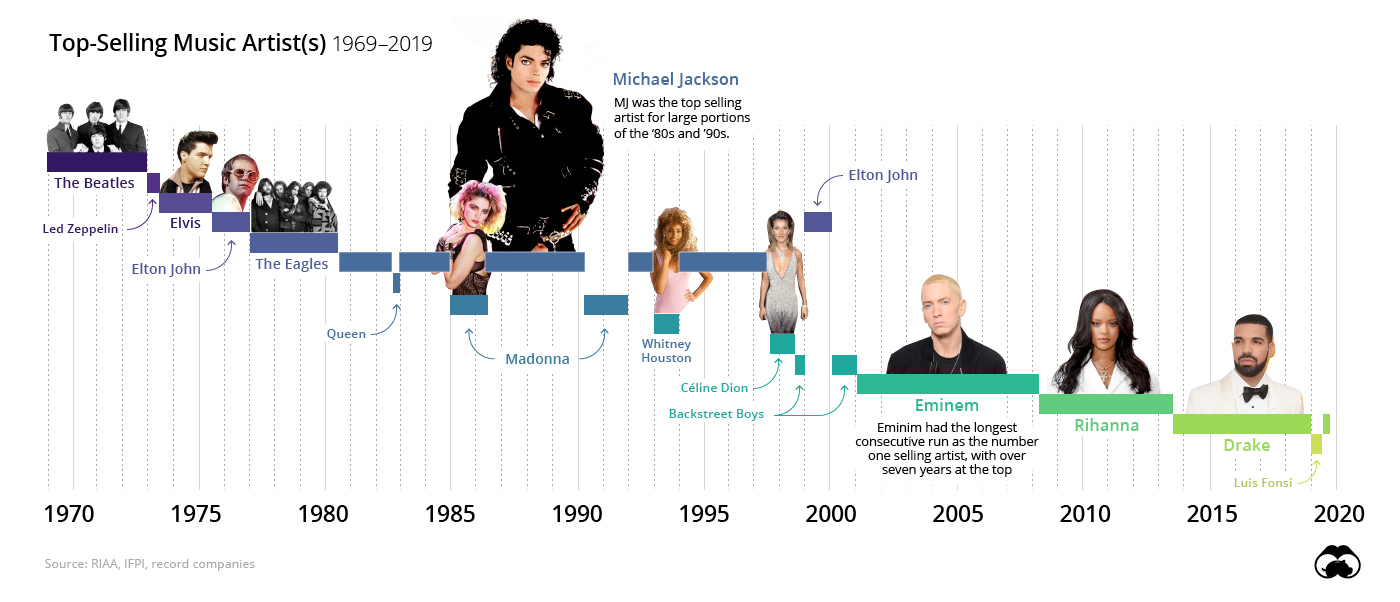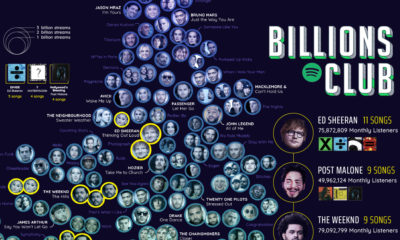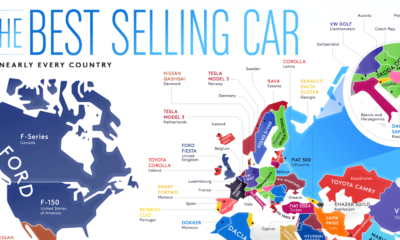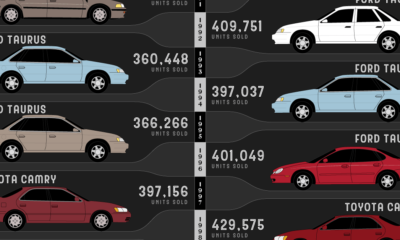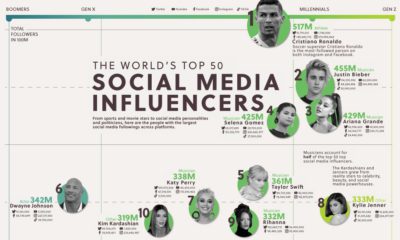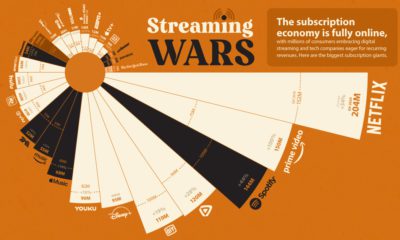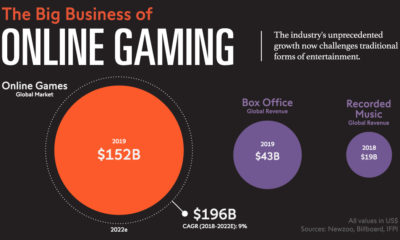Thanks to their relatability and creative prowess, these artists have not only boasted longevity in their record sales, but they’ve also dominated the charts year after year. Today’s video from Data is Beautiful visualizes the world’s best-selling music artists from the past 50 years (1969 to 2019) and highlights the length of their reigns. Do you see your favorite artist or group in the mix?
The Best Selling Artists, By Decade
Of all of the artists in the past half-century, two stand out: Michael Jackson and Eminem. Michael Jackson has the highest cumulative number of years in the top spot (~12 years), while Eminem holds the longest continuous best-selling artist slot (8.5 years). Let’s dive into each decade to uncover defining moments and key technology advancements that pushed the art of music into exciting new areas.
Expand image
1970s
This era of music is defined by the emergence of the rock genre, with artists like The Eagles and Led Zeppelin, the latter of which is widely considered a forefather of hard rock and heavy metal. The Beatles became known, not just for their music, but for pushing the envelope with how they recorded their music. They used analog sound editing techniques—utilizing a sound effect “bank” to record overtop finished music tracks to add depth and texture. This left a huge mark on the music world, and in many ways influenced how modern music is recorded. The introduction of 8-tracks and cassette tapes enabled people to play albums in their vehicles, opening up new possibilities for on-the-go entertainment.
1980s
Enter the age of electronic music—synthesizers, theremins, electronic samplers, and electronic drum kits popped up in the music scene, most predominantly in the United Kingdom and the United States. The German-based group Kraftwerk was one of the first to pioneer using a synthesizer in their sets. For example, one of the reasons for Michael Jackson’s success was that the technology of the time allowed for much wider distribution at much lower costs. In addition, Thriller was one of the first albums recorded on compact discs (CDs), which were introduced in 1982. The MTV era (launched 1981) also significantly impacted the sales of albums, as music now offered both visual and audio experiences—and broadcast directly into people’s homes.
1990s
A predominant factor of the 90s music scene was the explosion of popular music artists being commissioned to record the theme songs for blockbuster films. The most notable artists and their corresponding blockbuster movies of the time include:
Elton John ─ The Lion King Celine Dion ─ Titanic Whitney Houston ─ Bodyguard Bryan Adams ─ Robin Hood: Prince Of Thieves Madonna ─ Evita
While the 1990s marked a decade of great variety in top-selling artists, it was also the peak of the music industry’s sales, at a whopping $21.5 billion in 1999—a figure not since repeated.
2000s
Eminem dominated 2000s record sales, but the decade also featured brief stints from the Backstreet Boys in 2000 and Rihanna in 2009. Eminem helped to launch hip hop music into the mainstream. Being one of the most controversial best-selling artists of all time, he pushed genre boundaries through his technical prowess, wordsmithing, and relatability to wider audiences. The 21st century also brought music streaming services such as Spotify to the forefront, forever altering how people listen to their favorite artists and bands.
2010s
Only three artists have hit the best-selling artist spot in the current decade: Rihanna, Drake, and Luis Fonsi—the Puerto Rican singer most well known for his hit single “Despacito”. In 2016, the Recording Industry Association of America (RIAA) certified that Drake was the first music artist ever to reach #1 through streaming platform sales and downloads, instead of through physical album sales. According to RIAA, streaming revenues jumped from almost half of all music industry sales in 2017, to over 75% of sales in 2018—with $4.6 billion in total record sales as of Q1 2018.
The Future Of Music
Musicians are a creative breed, continuously experimenting with new instruments, sound effects, and recording styles. Some artists are even going so far as use only an iPhone to record their work—showcasing the modern-era ability to record high-fidelity quality and achieve studio-like results. With a new decade just around the corner, we may see even more possibilities for technology to revamp how we access our favorite tunes—and how artists distribute them to their fanbase. Who might become the next Beatles, Michael Jackson, or Drake? on Even while political regimes across these countries have changed over time, they’ve largely followed a few different types of governance. Today, every country can ultimately be classified into just nine broad forms of government systems. This map by Truman Du uses information from Wikipedia to map the government systems that rule the world today.
Countries By Type of Government
It’s important to note that this map charts government systems according to each country’s legal framework. Many countries have constitutions stating their de jure or legally recognized system of government, but their de facto or realized form of governance may be quite different. Here is a list of the stated government system of UN member states and observers as of January 2023: Let’s take a closer look at some of these systems.
Monarchies
Brought back into the spotlight after the death of Queen Elizabeth II of England in September 2022, this form of government has a single ruler. They carry titles from king and queen to sultan or emperor, and their government systems can be further divided into three modern types: constitutional, semi-constitutional, and absolute. A constitutional monarchy sees the monarch act as head of state within the parameters of a constitution, giving them little to no real power. For example, King Charles III is the head of 15 Commonwealth nations including Canada and Australia. However, each has their own head of government. On the other hand, a semi-constitutional monarchy lets the monarch or ruling royal family retain substantial political powers, as is the case in Jordan and Morocco. However, their monarchs still rule the country according to a democratic constitution and in concert with other institutions. Finally, an absolute monarchy is most like the monarchies of old, where the ruler has full power over governance, with modern examples including Saudi Arabia and Vatican City.
Republics
Unlike monarchies, the people hold the power in a republic government system, directly electing representatives to form government. Again, there are multiple types of modern republic governments: presidential, semi-presidential, and parliamentary. The presidential republic could be considered a direct progression from monarchies. This system has a strong and independent chief executive with extensive powers when it comes to domestic affairs and foreign policy. An example of this is the United States, where the President is both the head of state and the head of government. In a semi-presidential republic, the president is the head of state and has some executive powers that are independent of the legislature. However, the prime minister (or chancellor or equivalent title) is the head of government, responsible to the legislature along with the cabinet. Russia is a classic example of this type of government. The last type of republic system is parliamentary. In this system, the president is a figurehead, while the head of government holds real power and is validated by and accountable to the parliament. This type of system can be seen in Germany, Italy, and India and is akin to constitutional monarchies. It’s also important to point out that some parliamentary republic systems operate slightly differently. For example in South Africa, the president is both the head of state and government, but is elected directly by the legislature. This leaves them (and their ministries) potentially subject to parliamentary confidence.
One-Party State
Many of the systems above involve multiple political parties vying to rule and govern their respective countries. In a one-party state, also called a single-party state or single-party system, only one political party has the right to form government. All other political parties are either outlawed or only allowed limited participation in elections. In this system, a country’s head of state and head of government can be executive or ceremonial but political power is constitutionally linked to a single political movement. China is the most well-known example of this government system, with the General Secretary of the Communist Party of China ruling as the de facto leader since 1989.
Provisional
The final form of government is a provisional government formed as an interim or transitional government. In this system, an emergency governmental body is created to manage political transitions after the collapse of a government, or when a new state is formed. Often these evolve into fully constitutionalized systems, but sometimes they hold power for longer than expected. Some examples of countries that are considered provisional include Libya, Burkina Faso, and Chad.
